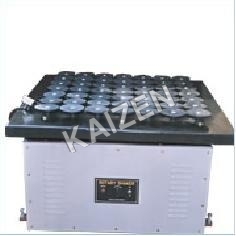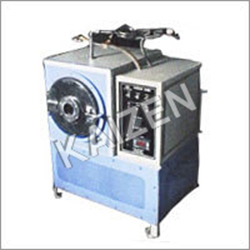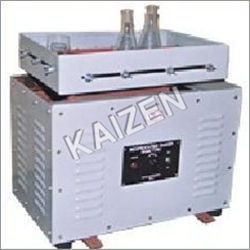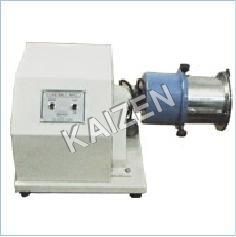

Rotary Shaker Horizontal
Product Details:
- Display Type Digital Display
- Features Silent operation, variable speed, robust construction, timer function
- Power Supply Single Phase, 50 Hz
- Speed Range 40180 RPM
- Accuracy 2 RPM
- Temperature Resistance Ambient to 60C
- Control Type Digital Speed Control
- Click to View more
Rotary Shaker Horizontal Price And Quantity
Rotary Shaker Horizontal Product Specifications
- Laboratory mixing, agitation & shaking
- Silent operation, variable speed, robust construction, timer function
- Mild Steel, Stainless Steel Platform
- Digital Display
- 220 W
- 40180 RPM
- 750 x 600 x 600 mm
- Laboratory Shaker
- 2 RPM
- Single Phase, 50 Hz
- 220 V AC
- Ambient to 60C
- Rotary Shaker Horizontal
- Mild Steel (Powder Coated Body), Stainless Steel Platform
- Rectangular
- Digital Speed Control
- 25 Ltr
Rotary Shaker Horizontal Trade Information
- Yes
- Sample costs shipping and taxes has to be paid by the buyer
- Middle East, Central America, Australia, South America, Western Europe, Asia, Eastern Europe, North America, Africa
- All India
- ISO Certification, MSME Certificate
Product Description
With years of domain expertise, we have etched a strong reputation as one of the well known manufacturers and exporters of Rotary Shaker Horizontal. Widely used for continuous shaking of solution in Eriynmeyer flask from 50-1000 ml capacity, this laboratory shaker is known for their high shaking speed which is controlled mechanically to work on 220/230 V AC supply. Our customers can avail this Rotary Shaker Horizontal in different technical specifications and designs.
Features:
- Low power consumption
- Compact design
- Optimum functionality
- Less maintenance
Other Details:
Compact bench type model with platform fitted with rubber dics, mounted in ball bearing crank shafts to give an orbital motion to the flask. The motor is coupled by means of V - belt with pitch pulley is mounted on a heavy and sturdy iron angel frame.
| Size | H.P |
| 45 x 45 cm ( to hold 25 flask of 100 ml ) | 0.25 |
| 45 x 45 cm ( to hold 36 flask of 50 ml ) | 0.25 |
| 45 x 45 cm ( to hold 49 flask of 25 ml ) | 0.25 |
| 45 x 45 cm ( to hold 16 flask of 250 ml ) | 0.25 |
| 55 x 55 cm ( to hold 25 flask of 250 ml ) | 0.25 |
| 60 x 60 cm ( to hold 36 flask of 250 ml ) | 0.5 |
| 100 x 100 cm ( to hold 81 flask of 250 ml ) | 1 |
Efficient Laboratory Mixing Solution
The Rotary Shaker Horizontal stands out for its high flask capacity, robust construction, and precise operation. Designed for laboratories demanding consistent agitation, the shakers digital speed control and timer function enable seamless, repeatable processes. Its mild steel body and stainless steel platform ensure longevity and resistance to laboratory conditions, making it an essential tool for any research or industrial environment requiring reliable sample mixing.
Flexible and User-Friendly Performance
Featuring a variable speed range of 40 to 180 RPM and silent operation, the shaker ensures comfortable laboratory environments. Its digital controls and timer add convenience and accuracy to workflows, while the platforms design secures various glassware sizes. Whether mixing cultures or dissolving samples, the rotary shakers adaptability enhances productivity and reliability in laboratory routines.
FAQs of Rotary Shaker Horizontal:
Q: How do you set up and operate the Rotary Shaker Horizontal?
A: Setting up the Rotary Shaker Horizontal is straightforward. Place the unit on a stable, level surface, secure your flasks onto the stainless steel platform using the flask clamps and rubber mat, then connect to a single-phase, 220V AC power supply. Use the digital controls to set your desired speed (40180 RPM) and timer (0120 minutes), and monitor the process on the digital display.Q: What types of laboratory applications is this shaker suitable for?
A: This rotary shaker is designed for various laboratory applications, including mixing, agitation, and shaking of samples in research, clinical, and industrial labs. With a capacity of 16 250 ml flasks and a 25 Ltr platform volume, its ideal for cell culture aeration, solution blending, and sample agitation.Q: When should you use the timer function on the shaker?
A: The timer function is best used when you require precise, time-controlled mixing tasks. For processes needing consistent duration, such as enzyme reactions or cell growth experiments, setting the timer (0120 minutes) ensures the shaker automatically stops after the designated period for reproducibility and safety.Q: Where can this rotary shaker be installed in the laboratory?
A: The shakers compact dimensions (750 x 600 x 600 mm) and rectangular shape allow it to fit conveniently on standard laboratory benches or dedicated equipment tables. Ensure the location has access to a 220V single-phase power outlet and is away from areas prone to moisture or direct heat.Q: What are the benefits of using a horizontal, reciprocating motion shaker?
A: The horizontal reciprocating linear motion ensures uniform agitation and mixing across all samples, which is essential for consistent results. This motion type is especially beneficial for applications in which even distribution of nutrients or reagents in flasks is required, promoting better experimental outcomes.Q: How does the digital speed control enhance laboratory workflow?
A: The digital speed control provides precise and repeatable speed adjustments within 40180 RPM, with 2 RPM accuracy. This consistency simplifies protocol standardization, improves experiment reliability, and allows users to tailor mixing conditions to specific protocol requirements.
Price:
- 50
- 100
- 200
- 250
- 500
- 1000+
Other Products in 'General Laboratory Instruments' category
 |
KAIZEN IMPERIAL
All Rights Reserved.(Terms of Use) Developed and Managed by Infocom Network Private Limited. |







